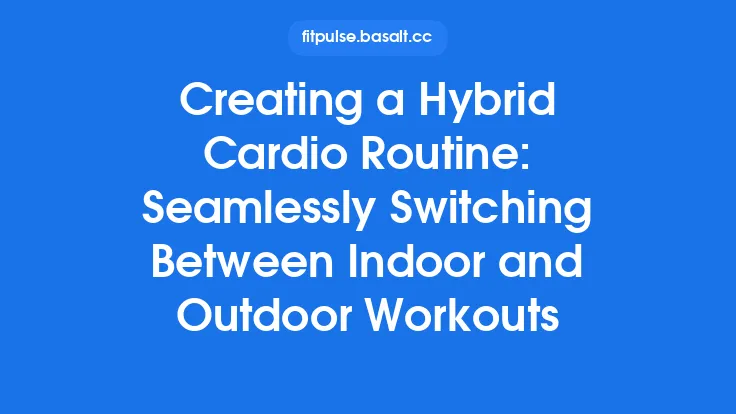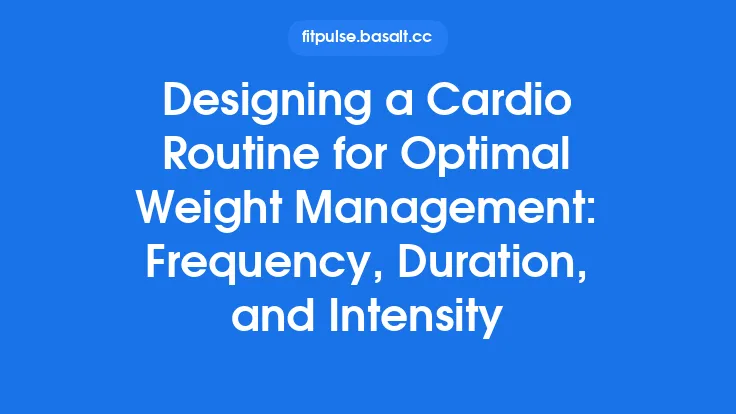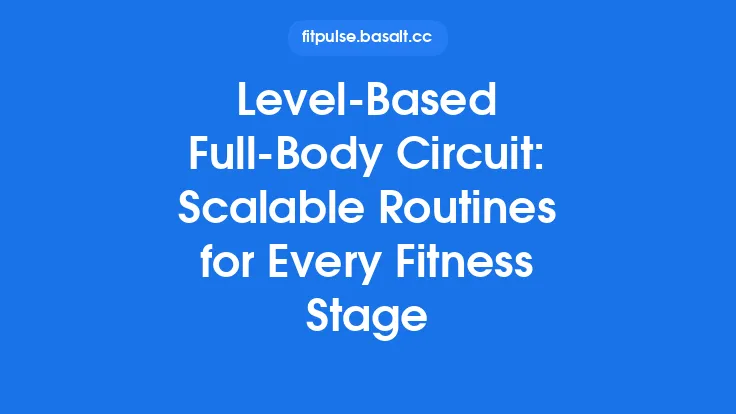Cardiovascular conditioning is a cornerstone of any well‑rounded fitness program, yet the decision of where to perform that cardio—inside a climate‑controlled space or out on the open road, trail, or track—can be surprisingly nuanced. While both environments can deliver the same physiological stimulus, the surrounding context influences everything from energy expenditure to biomechanical stress, recovery timelines, and long‑term adherence. Below is an in‑depth exploration of the advantages and disadvantages of indoor versus outdoor cardio, broken down by fitness level and key training variables, to help you make an evidence‑based choice that aligns with your goals, schedule, and body mechanics.
1. Beginner Considerations
Physiological Load
- Heart‑Rate Zones: For novices, staying within 50‑70 % of maximal heart rate (HRmax) is ideal for building aerobic base. Indoor treadmills, stationary bikes, and elliptical machines provide precise heart‑rate feedback and often include built‑in zone calculators, making it easier to stay in the target range.
- Metabolic Efficiency: Early cardio sessions rely heavily on oxidative phosphorylation. Indoor environments with stable temperature and humidity reduce the metabolic cost of thermoregulation, allowing beginners to focus on technique rather than coping with external stressors.
Pros of Indoor Cardio for Beginners
- Controlled Pace & Resistance: Machines let you set exact speeds, inclines, and resistance levels, which is valuable for progressive overload without overexertion.
- Safety Net: Soft, predictable surfaces (e.g., treadmill decks) lower impact forces on the joints, decreasing the risk of early overuse injuries.
- Convenient Monitoring: Integrated displays track distance, cadence, and calories, providing immediate feedback that reinforces learning.
Cons of Indoor Cardio for Beginners
- Limited Motor Variability: Repetitive motion on a single machine can lead to muscular imbalances if not complemented with other movement patterns.
- Reduced Proprioceptive Challenge: Outdoor terrain naturally engages stabilizer muscles and balance systems, which are under‑stimulated in a static indoor setting.
Pros of Outdoor Cardio for Beginners
- Natural Variability: Uneven surfaces, gentle hills, and wind resistance introduce low‑level interval stimuli that can accelerate aerobic adaptations without formal programming.
- Engagement of Stabilizer Muscles: Walking or jogging on grass, sand, or trail surfaces activates ankle dorsiflexors, intrinsic foot muscles, and core stabilizers, fostering functional strength.
Cons of Outdoor Cardio for Beginners
- Unpredictable Intensity: Sudden changes in terrain or pace can unintentionally push a beginner into higher HR zones, increasing perceived exertion and fatigue.
- Environmental Stressors: Even moderate temperature fluctuations can raise the thermoregulatory load, making it harder to maintain a steady aerobic stimulus.
Practical Takeaway
For most beginners, a hybrid approach—starting with indoor sessions to master pacing and technique, then gradually introducing short outdoor walks or jogs—offers the best balance of safety, progression, and functional development.
2. Intermediate Athletes
Training Objectives
At the intermediate stage, athletes typically aim to improve cardiovascular efficiency (e.g., VO₂ max), increase lactate threshold, and begin incorporating sport‑specific conditioning.
Indoor Advantages for Intermediates
- Precise Interval Programming: Machines allow exact control over work‑rest ratios, making it simple to execute high‑intensity interval training (HIIT) protocols such as 4 × 4‑minute intervals at 90‑95 % HRmax with 3‑minute active recovery.
- Consistent Load for VO₂ Max Testing: Laboratory‑style treadmill or cycle ergometer tests can be replicated at home or in a gym, providing reliable data for tracking progress.
- Reduced Joint Load for High Volume: For athletes accumulating high weekly mileage, low‑impact indoor options (e.g., rowing, elliptical) enable volume maintenance while sparing the knees and hips.
Indoor Disadvantages for Intermediates
- Limited Mechanical Stress: Without the eccentric loading of downhill running or the lateral forces of trail navigation, indoor cardio may not fully develop the musculoskeletal resilience needed for outdoor sport performance.
- Potential for Monotony: Repetitive indoor sessions can diminish motivation, which may affect adherence over the long term.
Outdoor Advantages for Intermediates
- Terrain‑Induced Load Variability: Natural hills provide built‑in progressive overload, stimulating both aerobic and anaerobic systems without the need for programmed resistance changes.
- Enhanced Neuromuscular Coordination: Navigating uneven ground improves proprioception, foot strike mechanics, and reactive strength—key components for sports such as soccer, basketball, and trail running.
- Higher Energy Expenditure: The added cost of moving against wind resistance and negotiating variable terrain can increase caloric burn by 5‑15 % compared with a flat indoor surface at the same speed.
Outdoor Disadvantages for Intermediates
- Difficulty Replicating Exact Workloads: Without a calibrated device, maintaining precise interval durations and intensities can be challenging, potentially leading to suboptimal stimulus.
- Increased Musculoskeletal Stress: The higher impact forces associated with outdoor running, especially on hard surfaces, raise the risk of overuse injuries such as patellofemoral pain syndrome or tibial stress fractures.
Strategic Recommendation
Intermediate athletes should leverage indoor sessions for structured interval work and VO₂ max testing, while using outdoor sessions to develop terrain‑specific strength, neuromuscular control, and higher‑intensity endurance bursts. Periodizing the two environments—e.g., indoor HIIT on Mondays and Thursdays, outdoor hill repeats on Saturdays—optimizes adaptation while mitigating injury risk.
3. Advanced Performers
Performance Goals
Advanced cardio athletes often target maximal aerobic capacity, race‑specific pacing, and fine‑tuned metabolic efficiency. At this level, marginal gains become critical.
Indoor Strengths for Advanced Athletes
- Exact Replication of Race Pace: Treadmills equipped with programmable pacing can simulate marathon or half‑marathon splits down to the second, allowing athletes to rehearse race strategy under controlled conditions.
- Environmental Control for Heat Acclimation: Some advanced facilities feature climate chambers where temperature and humidity can be manipulated, enabling systematic heat adaptation without the unpredictability of outdoor weather.
- Data‑Rich Feedback: High‑end ergometers provide power output (watts), cadence, and torque curves, facilitating precise power‑based training—a cornerstone of elite cycling and rowing programs.
Indoor Limitations for Advanced Athletes
- Lack of Real‑World Variability: Even the most sophisticated treadmill cannot fully reproduce the stochastic nature of outdoor wind gusts, surface compliance, or elevation changes that affect pacing and energy cost.
- Reduced Mechanical Stress for Bone Density: High‑impact outdoor running contributes to bone remodeling; indoor low‑impact modalities may not provide sufficient osteogenic stimulus for athletes at risk of low bone mineral density.
Outdoor Strengths for Advanced Athletes
- Specificity of Training: For road racers, trail runners, or cyclists, outdoor sessions replicate the exact biomechanical and environmental demands of competition, enhancing transfer of training effects.
- Dynamic Load Management: Natural terrain allows athletes to practice “negative splits,” progressive pacing, and tactical surges that are difficult to emulate on a flat indoor surface.
- Psychophysiological Edge: The sensory richness of outdoor environments (visual landmarks, auditory cues) can improve mental pacing cues and reduce perceived exertion, a subtle but measurable performance enhancer.
Outdoor Limitations for Advanced Athletes
- Variability in Data Accuracy: While GPS watches and power meters provide useful metrics, signal loss, satellite drift, and terrain‑induced power estimation errors can compromise data fidelity.
- Higher Cumulative Joint Load: The repetitive high‑impact forces of elite-level outdoor running can accelerate wear on cartilage and tendons, necessitating careful periodization and cross‑training.
Optimization Strategy
Advanced athletes should adopt a “specificity‑first” philosophy: schedule the majority of race‑specific workouts outdoors, while reserving indoor sessions for precise power or pace intervals, recovery rides, and controlled heat or altitude simulations. Incorporating low‑impact indoor cardio (e.g., rowing) during high‑volume phases can preserve joint health without sacrificing aerobic stimulus.
4. Core Physiological Differences Between Environments
| Parameter | Indoor Setting | Outdoor Setting |
|---|---|---|
| Thermoregulatory Load | Minimal; ambient temperature is stable, reducing sweat rate and cardiovascular drift. | Variable; wind, solar radiation, and ambient temperature increase sweat loss and cardiac output to maintain core temperature. |
| Mechanical Stress | Typically lower impact (treadmill belt, stationary bike). | Higher impact (hard pavement, uneven trails) and eccentric loading (downhill running). |
| Oxygen Availability | Consistent barometric pressure; no altitude changes. | Potential altitude fluctuations (e.g., hill climbs) that can transiently lower partial pressure of oxygen, stimulating erythropoietic adaptations. |
| Neuromuscular Demand | Repetitive, planar motion; limited proprioceptive challenge. | Multiplanar movement, variable foot placement, and reactive balance demands. |
| Energy Expenditure | Predictable; primarily dependent on speed, incline, and resistance. | Additional energy cost from wind resistance, terrain irregularities, and micro‑adjustments in stride. |
Understanding these differences helps athletes select the environment that aligns with the specific physiological stimulus they wish to prioritize.
5. Training Variables to Manipulate in Each Setting
- Intensity (Heart‑Rate / Power)
- Indoor: Use calibrated power meters (cycling ergometers) or treadmill speed/incline to hit exact percentages of HRmax or lactate threshold.
- Outdoor: Rely on GPS‑based speed zones, perceived exertion, or wearable power meters (e.g., pedal‑based) to approximate target intensity.
- Duration & Volume
- Indoor: Easily schedule long, steady‑state sessions without external interruptions.
- Outdoor: May need to account for traffic, terrain, and daylight, which can naturally segment workouts into shorter, more varied bouts.
- Interval Structure
- Indoor: Program precise work‑rest intervals (e.g., 30 s sprint / 90 s jog) with automated alerts.
- Outdoor: Use natural landmarks (e.g., “run to the next tree”) to cue intervals, fostering a more organic pacing sense.
- Recovery Modality
- Indoor: Low‑impact machines (elliptical, rowing) provide active recovery while minimizing joint stress.
- Outdoor: Walking or easy jogging on soft surfaces can enhance circulation and promote metabolic waste clearance.
6. Practical Logistics
- Space & Accessibility
- Indoor cardio requires a dedicated area or gym membership; the trade‑off is convenience and year‑round availability.
- Outdoor cardio leverages public spaces (parks, trails) and often incurs no cost, but may be limited by distance to suitable routes.
- Equipment Maintenance
- Treadmills, bikes, and ellipticals need periodic servicing (belt tension, calibration).
- Outdoor gear (running shoes, bike tires) also requires regular inspection, but the wear patterns differ (e.g., tread wear vs. road abrasion).
- Time Efficiency
- Indoor sessions can be shorter yet equally effective due to controlled intensity (e.g., 20‑minute HIIT).
- Outdoor sessions may require longer warm‑up and cool‑down periods to accommodate variable conditions.
7. Injury Risk and Recovery
| Risk Factor | Indoor Environment | Outdoor Environment |
|---|---|---|
| Impact‑Related Overuse | Lower impact reduces stress on tibia, patella, and hip joint. | Higher impact, especially on hard surfaces, increases risk of stress fractures and tendinopathies. |
| Muscle Imbalance | Repetitive motion can over‑develop specific muscle groups (e.g., quadriceps on a treadmill). | Varied terrain promotes balanced development of anterior/posterior chain and stabilizer muscles. |
| Acute Trauma | Fewer obstacles; risk mainly from equipment malfunction. | Trip hazards, uneven ground, and traffic increase acute injury potential. |
| Recovery Facilitation | Controlled environment allows for precise post‑exercise cooling (air‑conditioned rooms). | Natural cooling (shade, breeze) can aid post‑exercise thermoregulation but may be inconsistent. |
Mitigation Strategies
- For indoor cardio, incorporate cross‑training (e.g., rowing, swimming) to address muscular imbalances.
- For outdoor cardio, schedule regular “soft‑surface” days (grass, sand) and integrate strength work targeting eccentric control to protect joints.
8. Adaptation and Progression
- Progressive Overload
- Indoor: Increase treadmill incline by 1‑2 % increments, raise bike resistance, or add interval repetitions.
- Outdoor: Add hill repeats, extend route distance, or incorporate interval sprints on varied terrain.
- Periodization
- Macrocycle: Alternate blocks of indoor‑focused high‑intensity work with outdoor‑focused endurance phases.
- Mesocycle: 4‑6 week cycles where the primary stimulus (e.g., VO₂ max) is targeted in the indoor setting, followed by a 2‑3 week block emphasizing outdoor-specific strength and neuromuscular adaptation.
- Monitoring Adaptation
- Track resting heart rate, HRV, and perceived recovery scores after both indoor and outdoor sessions to gauge systemic stress.
- Use lactate threshold testing (lab or field) periodically to confirm that training intensity aligns with physiological markers.
9. Summary of Pros and Cons Across Fitness Levels
| Fitness Level | Indoor Pros | Indoor Cons | Outdoor Pros | Outdoor Cons |
|---|---|---|---|---|
| Beginner | Precise pacing, low joint impact, easy monitoring | Limited proprioceptive challenge, potential monotony | Natural variability, functional stability work | Unpredictable intensity, environmental stress |
| Intermediate | Structured intervals, VO₂ max testing, volume control | Less mechanical stress for sport‑specific adaptation | Terrain‑induced load, higher calorie burn, neuromuscular gains | Difficulty replicating exact workloads, higher injury risk |
| Advanced | Exact race‑pace simulation, climate control, power data | Lack of real‑world variability, lower osteogenic stimulus | Specificity to competition, dynamic load, mental pacing cues | Data accuracy issues, cumulative joint load |
10. Final Thoughts
Choosing between indoor and outdoor cardio is not a binary decision but a strategic balance of physiological demands, personal circumstances, and long‑term goals. Beginners benefit from the safety and precision of indoor equipment while gradually introducing outdoor sessions to develop functional stability. Intermediates should exploit indoor environments for targeted interval work and outdoor terrain for neuromuscular robustness. Advanced athletes must prioritize sport‑specific outdoor training while using indoor sessions for exact pacing, power control, and controlled environmental stressors.
By understanding the distinct pros and cons at each fitness level and aligning them with the core training variables—intensity, duration, interval structure, and recovery—you can craft a cardio regimen that maximizes adaptation, minimizes injury, and sustains motivation over the years. Whether you lace up your shoes for a treadmill run at dawn or hit the trail at sunset, the key is intentionality: select the environment that best delivers the stimulus you need, when you need it, and enjoy the journey toward a healthier, stronger cardiovascular system.





